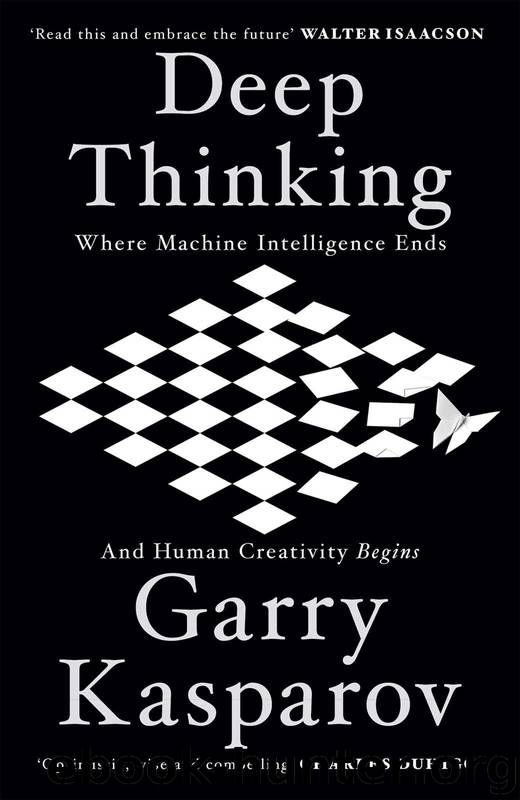B01M1GEJJK EBOK by Unknown

Author:Unknown
Language: eng
Format: azw3
Publisher: Hodder & Stoughton
Published: 0101-01-01T00:00:00+00:00
CHAPTER 8
DEEPER BLUE
KEN THOMPSON designed the revolutionary chess machine Belle, whose chips Deep Blue’s were based on, while working at Bell Laboratories in New Jersey, the famous “Idea Factory” that did pioneering work on breakthroughs in everything from solar cells and lasers to transistors and cell phones. Thompson was also the principal inventor of the ubiquitous Unix operating system while there, which is the basis for what runs Apple Macs, Google Android, and the billions of devices and servers running Linux.
As with the early years of ARPA, the concept at Bell Labs was to describe big problems and then work on creating the technology to solve them, instead of starting with a specific product in mind. I heard similar stories when I was invited to speak at General Electric’s new Innovation Center near Detroit in 2010. My hosts were eager to stimulate the sort of “blue sky” thinking that had gone out of fashion after decades of industry consolidation and acquisitions. During my seminar, someone pointed out that too often giant companies assume that even if they aren’t innovating, somebody is somewhere, and when something good comes along they will simply buy it. You can see how it eventually becomes a problem when everybody thinks somebody else will innovate.
I was reminded of this particular seminar in the context of chess machines because of a slide I used with a quote from Alan Perlis, a computer science pioneer and the first recipient of the Turing Award, in 1966, awarded by ACM. In a famous list of epigrams about programming that he published in 1982, Perlis wrote, “Optimization hinders evolution.” This jumped out at me because it at first sounds contradictory. How could making improvements in something prevent it from evolving? Isn’t evolution itself a type of steady improvement?
But evolution isn’t improvement; it’s change. Usually from simple to complex, but the key to it is increasing diversity, a shift in the nature of a thing. Optimization can make computer code faster but it won’t change its nature or create anything new. Perlis liked to show an “evolutionary tree” of programming languages, and how one led to another by evolving to fit needs and adapt to new hardware environments. He explained how ambitious goals are what lead to evolution because they create unexpected needs and new challenges that cannot be met only by optimizing existing tools and methods.
It’s also a matter of opportunity cost. If the focus is too heavily on optimizing, nothing new is created and stagnation can result. It can be too easy to concentrate only on making something better when we might be better served by making something new, something different.
Perlis’s adage can be applied broadly beyond programming, although care should be taken not to overdo it. It has itself evolved into the popular “optimization is the enemy of innovation,” which ropes in another slippery term. Many things we call innovations are little more than the skillful accumulation of many little optimizations. There wasn’t much new technology in the first iPhone, for example; it wasn’t even the first of its kind.
Download
This site does not store any files on its server. We only index and link to content provided by other sites. Please contact the content providers to delete copyright contents if any and email us, we'll remove relevant links or contents immediately.
What's Done in Darkness by Kayla Perrin(25501)
Shot Through the Heart: DI Grace Fisher 2 by Isabelle Grey(18220)
Shot Through the Heart by Mercy Celeste(18160)
The Fifty Shades Trilogy & Grey by E L James(17777)
The 3rd Cycle of the Betrayed Series Collection: Extremely Controversial Historical Thrillers (Betrayed Series Boxed set) by McCray Carolyn(13190)
The Subtle Art of Not Giving a F*ck by Mark Manson(12915)
Scorched Earth by Nick Kyme(11834)
Stepbrother Stories 2 - 21 Taboo Story Collection (Brother Sister Stepbrother Stepsister Taboo Pseudo Incest Family Virgin Creampie Pregnant Forced Pregnancy Breeding) by Roxi Harding(11040)
Drei Generationen auf dem Jakobsweg by Stein Pia(10217)
Suna by Ziefle Pia(10186)
Scythe by Neal Shusterman(9265)
International Relations from the Global South; Worlds of Difference; First Edition by Arlene B. Tickner & Karen Smith(8614)
Successful Proposal Strategies for Small Businesses: Using Knowledge Management ot Win Govenment, Private Sector, and International Contracts 3rd Edition by Robert Frey(8419)
This is Going to Hurt by Adam Kay(7698)
Dirty Filthy Fix: A Fixed Trilogy Novella by Laurelin Paige(6454)
He Loves Me...KNOT by RC Boldt(5805)
How to Make Love to a Negro Without Getting Tired by Dany LaFerrière(5378)
Interdimensional Brothel by F4U(5305)
Thankful For Her by Alexa Riley(5164)
